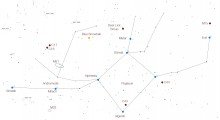You can’t miss the great square of Pegasus in the eastern sky at this time of year; it’s one of the most recognisable asterisms up there. The flying horse of Greek mythology, upon which Perseus rode when he freed the princess Andromeda, and later, upon which Bellerophon rode when he slayed the Chimaera, appears to fly vertically up from the eastern horizon.
Visible just after dark (around 8.00pm these days), the lowest star of the ‘square’ of Pegasus is Algenib, roughly 391 light years away. This is a very bright star, approximately 9 times the mass of our sun, and the fourth brightest in the constellation. It appears blue/white when viewed with a telescope or binoculars, and can be used as a star hopping point from which to locate the edge on galaxy Caldwell 43. At around 40 million light years away, and magnitude 10.5, I’d reckon you’d need at least an 8 inch aperture telescope to find it.
The right-hand star of the square is Markab, a giant star, roughly five times the radius of our sun. Below and to the right of Markab is C44, another mag 11 galaxy, but this time 105 million light years away! Again, like with C43, aperture will be required.
To the right of Markab, we have the mag 3 stars Homan and Biham, and above them the supergiant Enif (or Epsilon Pegasi). With its orange colour and radius 185 times that of the sun, it’s estimated that Enif has only a few million years left to go before exploding in a supernova.
Above Enif is the globular cluster M15. Home to around 100,000 stars, it’s the most densely packed globular in the galaxy, and is (just) visible in 10×50 binoculars (magnifications of x50 and above will start to show individual stars in the cluster).
The uppermost star of the square of Pegasus is Scheat, an orange giant star, about 95 times as large as the sun, and above Scheat is Matar, a very tight double star (some even think that it’s a pair of double stars!). Above and left of Matar is the Deer Lick group of galaxies, which includes Caldwell 30 (NGC 7331) and Stephan’s Quintet. C30 is is a large and bright spiral galaxy about 40 million light years away, and is visible in small to medium telescopes. Stephan’s Quintet, on the other hand, will only be visible in a 10 inch reflector and larger (even then, it will be a good night if you see it).
The left-hand star of the ‘square’ is Alpheratz, a close orbit double star 97 light years from Earth, and actually part of the Andromeda constellation as well as Pegasus. Interestingly, Delta Andromeda, Mirach and Almaak (all to the left of Alpheratz, and which together form a row of stars at the base of the Andromeda constellation) are all multiple star systems. Next to Mirach is the galaxy NGC 404, also known as Mirach’s Ghost (a dwarf lenticular galaxy around 10 million light years away); a five inch reflector should be able to pick it up.
Above Mirach lies Mu Andromeda (a very young star – about 600 million years old, and about twice the size of the sun), and above that lies the Andromeda galaxy itself. Best viewed at low magnification (because it’s so big) – and binoculars are ideal for this – the companion galaxies M32 and M110 will require telescope assistance.
Above and to the left of the Andromeda galaxy are C17 and 18, a pair of dwarf galaxies around 2.3 million light years away; they’re a challenge, and require aperture to find …
Roughly in between C17/18 and the Deer Lick group of galaxies is the Blue Snowball nebula. It’s also a challenge, benefits from higher magnification, but is definitely worth taking the time to track it down. It’s definitely one of my favourite planetary nebulae.
Almaak (at the far left side of the Andromeda constellation) is comprised of a bright, golden yellow star next to a dimmer, indigo blue star, and really is an exceptional sight. Below and to the right of it is C28, an open cluster of around 60 stars, 1200 light years away.
The last stop of this tour of the eastern sky is the Triangulum galaxy (M33); below Mirach (and slightly to the left). Although not actually part of the constellations under discussion, it makes sense to have a look while you’re in the area, and 10×50 binoculars will pick it up.
Together, the constellations of Pegasus and Andromeda occupy a very large sector of the eastern sky, and there’s lots to see there.
What’s up?
We’ve got a fantastic opportunity to do some dark sky observing in the run up to the new moon on the 1st of October. The Pleiades and Hyades star clusters in Taurus, along with M36, 37 and 38 open clusters in Auriga are very well placed from about 10.30, and are fantastic objects.
Uranus and Neptune are also still well placed, while for those looking for a harder target, Messier 74 is a spiral galaxy, 32 million light years away in the constellation of Pisces. Supposedly one of the hardest Messier objects to find, it should just be possible with 10×50 binoculars.
Those up and about after midnight might like to check out the red supergiant star Betelgeuse, in Orion; apparently it’s been getting brighter recently …
Clear skies!
Kevin Quinn is an amateur astronomer based in Cerne Abbas. He is the proud owner of a ten-inch reflector, a small refractor, a case of eyepieces, and a couple of pairs of binoculars. He tweets via @CerneAstro, and blogs (occasionally) via theastroguy.wordpress.com.
©Kevin Quinn







